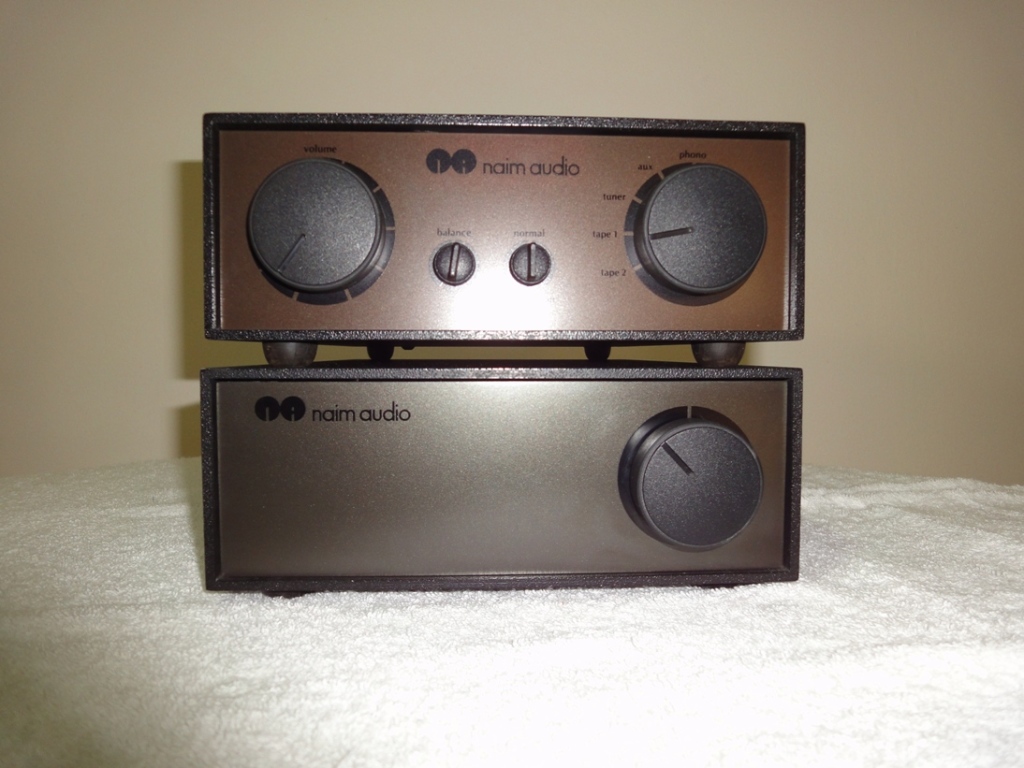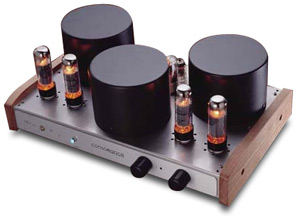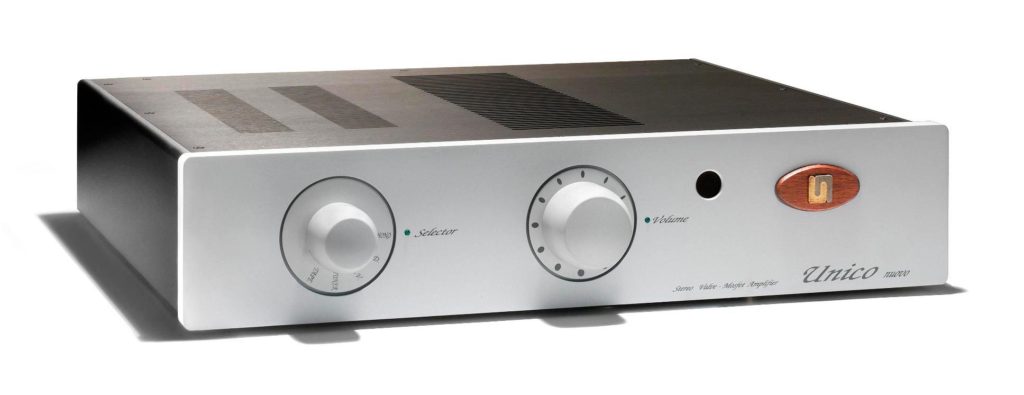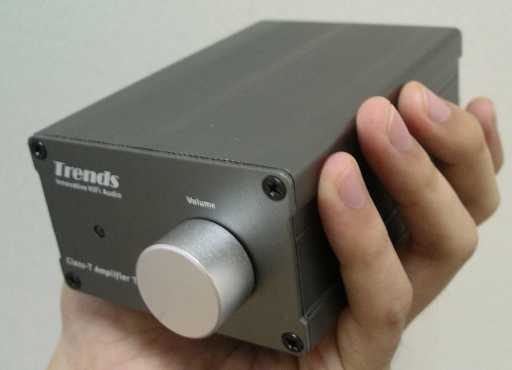Pre + power? Is it worth it..? Tubes? Same…
The electric signal coming out of a source needs to be amplified before being routed to the loudspeaker system. The most widespread are the integrated amplifiers design, where the preamplifier section and the power sections are in the same box. The pre section is where the different sources are selected and sound volume and tone are regulated. The power section provides the amplification of the signal so that the loudspeaker can use it to deliver sound (a very good classic example of pre+power units is this one from Naim Audio, below).
But we better stay with less complicated integrated amplifiers, to begin with. Matching pre and power amplifiers, maybe of different brands and two mono finals, is a way of looking for trouble. The integrated amp is certainly the easiest solution even if you buy used (see Audio Analogue, Rotel, Arcam
, NAD
, Cambridge Audio
). In order to amplify a signal, the power section of an integrated amp or the power amp separate, may use tubes, transistors or mosfets. Tube amplifiers are very fashionable, but are more complicated to use and match, let alone for maintaining. Forget the idea of a warm sounding tube amplifier: there are cold valve amps and warm integrates. So, if you’r looking for a warm sound you mustn’t necessary look for a tube amp. A real trouble is when you have to look for the right tubes when the originals have come to an end. So we better focus on solid state amplifiers. In the past, the only way to amplify a signal was by means of a valve. Than the transistors came, doing the same thing using much less space (and lasting much longer). Mosfets are a particular kind of transistors that can deliver a better sound a higher costs. In summary, the ideal would be a mosfet integrated, but it is not strictly necessary. A quality transistor integrated amp can donate immense acoustic satisfaction with less complications than a valve pre+power amp…
How many Watts? Is this a problem?
About the power: you don’t need much. You just need the necessary amount to drive the speakers well and fill the room with sound. And by driving the speakers well, we mean having enough reserve to push them during musical peaks without distorting the signal (otherwise you risk damaging the speakers). But it’s no use exaggerating in an apartment flat. We would bust our eardrums and annoy the neighbors. We would also get tired early of that fatigue. This is contrary to the philosophy of HiFi. In our homes we just need relatively low volume and a much powerful amplifier is a waste of money and electrical energy. The Watt number is not important, their quality is. And so is their ratio to the speakers’s sensitivity, besides the volume of the listening room. A well built 20-watt integrated, or even less, is all you need at home. Just don’t couple it with low efficiency loudspeakers (< 90 dB at 1 Watt at 1 m). Low impedance speakers (4-6 Ohm) need may need high currents, especially during music peaks. But usually modern amps are designed to work well with most of the speakers on the market.
So, you like a pair of low sensitivity speakers? Your amp will have to get a good current reserve and some more Watt. Otherwise you don’t need more than 5 or 6. At home, 90 dB of sound pressure are really, really high. Think about a a driver at 1 m distance: 1 Watt of power yields a sound level of 90 dB, which is the average sensitivity of loudspeaker systems on the market. Doubling the distance you lose 3 dB; doubling the power you gain 3 dB. At 2 m distance we go down to 87 dB, a very good level with just … 1 Watt! Ok, this is with a single speaker in an anechoic room (non reflective walls); at home, wall reflections abound and we increase the level of about 4 dB, so we’re at 91 dB. We should consider a couple of loudspeakers. This make other 3 dB more, and we reach 94 dB a 2 meters in our home with just 1 Watt of power. Doubling it at 2 Watts we would gain additional 3 dB, therefore we would get 100 dB and we’d feel like we were in a disco using just 4 Watts. Therefore, stop talking about the power of amplifiers, it is nonsense, let’s not fool ourselves…
Tone controls, loudness, equalizer? Useless if not harmful…
About the preamplifier section, the only thing that really counts is the volume control. You’ll be surprised that we can talk about quality even concerning the volume knob, or gain. Consider that any circuitry we put between the signal and the speakers potentially degrades the sound. The less circuits the signals passes through, the better. Simplicity is virtue, here. The gain control is necessary, so it better be good. But most important is to realize that tone control are of no use. Playing with bass and treble could even cause damage. A serious amp does not need them (see the very good Unison Research Unico integrated amp, below).
They are only a useless additional circuitry to mess with the signal. If you stumble upon an integrated with tone controls, or even worse with the loudness switch, make sure there also is a swith to cut them off. If not, test the amp with tone controls at zero (flat) and the loudness off. Tome controls and loudness have been devised to compensate for the human ear’s loss of response to highs and lows at low volume. If at normal volumes an amp sounds good only with tone corrections, something is wrong or, simply, it is not a very good amplifier. Furthermore, using tone controls to enhance highs and lows, as well as the loudness switch at high volume means jeopardizing the drivers. You don’t want to run the risk. Tone controls could be useful since each different room highlights or attenuates certain frequencies. But tone controls affect a fixed frequency range, not necessarily what we need. A useful tool would be a parametric equalizer, where we can choose the frequencies we want to act upon. But only a very trained ear can recognize the frequencies that need adjustment without the right tools. It should be clear now how we should not worry about those problems and take great care in curing the listening environment, since it is the most important component of our HiFi systems.
New tech advances – Class D (or T?)
A special nomination goes to class D amplifiers, on the market in the recent years. I won’t dwell on the technology within, suffice to say D is not for digital. The amplification is analog (transistors and mosfets) but there are digital controls through dedicated chips, which transform the signal prior to amplification. The result is more efficient amplifiers that dissipate less heat. What we really need to know is that the various models that hit the market after the first one to receive a wide acceptance (the T-Amp, so-called Class T amplifier but it is only a particular kind of class D amplifier using a Tripath chip), have all amazed the public with a surprising good sound at very low prices. With less than 100-200 euros you can put your hands on low power amps, even less than 10 Watt, with an astounding sound quality.
It seems they might compare to amplifiers costing up to 10 or even 100 times higher! Is this the technology of the future? Probably. Assembling a first system you shouldn’t avoid considering small integrates of this kind among brands such as Trends Audio (above right), Dayton (right), Schyte. The main issue is the lack of inputs, one or two in many models. If you have several sources you will need a preamplifier and a class D power amp. If you can spend more, Nuforce offers a good integrated amp with 4 inputs. If you are into vinyl, you better go for a traditional integrated amp with a phono input. Usually, class D amplifiers work best with high efficiency (= high sensitivity) loudspeakers, considering the low Watts they have. Again, a few Watts, even less than 10, are just enough for home playback. A 100-Watt amp is out of proportions in most cases. The huge sound quality of these amplifiers won’t make you feel you need more Watts, although some recent class D amps sport tens of Watts at …embarrassing prices.
Secrets of Amplifier and Speaker Power on axiomaudio.com
The decibel on wikipedia.org



